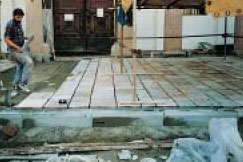|
|
 |
 |
 |
    |
 |
You can reach us by
e-mail, phone or regular
mail. We look forward
to hearing from you.
818-402-0711 more
|
|
 |
|
|
|
|
|
|
 |
 |
 |
   |
 |
|
|
 |
 |
Fig. 104 - Section of tile paving.
|
Setting techniques: tiles and flagstone
for paving
The setting of tiles and flagstone usually
follows three separate phases: foundation
preparation, setting bed and grouting (Fig.
104). In some cases, tiles and giant flagstone
can be set on sand.
|
 |
Fig. 105 - Setting bed preparation
for tile paving.
|
 |
Fig. 106 - Tile installation in
setting bedding.
|
Foundation
With tiles and flagstone too, the foundation
can be ballast ("Macadam", "crush
and run") or concrete slab as for cubetti.
For the ballast, a layer of compacted
gravel is prepared, with an upper surface
of smaller-graded gravel for better compactness
(Fig. 105 and 106).
In the case of a concrete slabe foundation,
a 10-15 cm layer of concrete is
mixed with 250 kg of cement per each
cubic metre of suitably graded inert material,
slightly reinforced against shrinkage.
In some cases, these two types of
foundation can be combined and the related
thicknesses varied according to requirements.
Setting Bed
The bedding layer differs according to
whether the stone paving has variable or
constant thickness.
The most commonly used setting bed
|
| Table 18 - Total paving thickness based on the tile thickness. |
 |
 |
|
|
 |